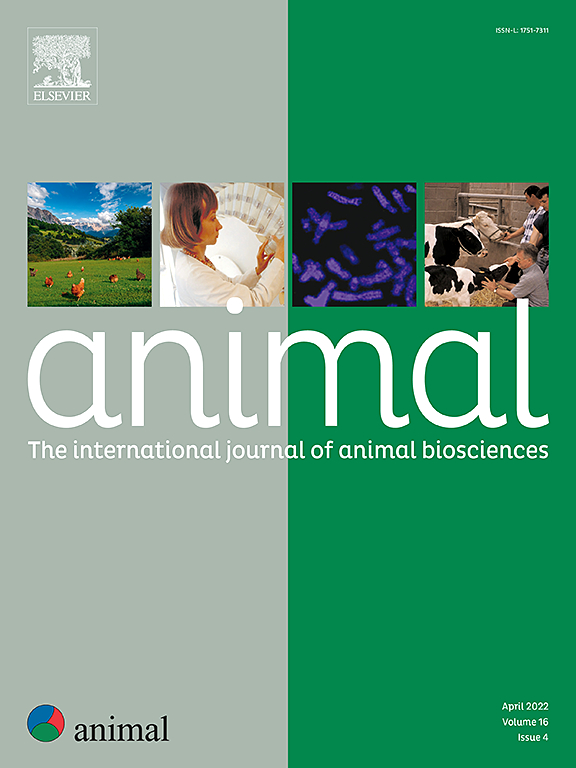温带海洋性气候下草地和农林复合系统饲养肥猪的健康和生产性能
IF 4.2
2区 农林科学
Q1 AGRICULTURE, DAIRY & ANIMAL SCIENCE
引用次数: 0
摘要
室外养猪通常被认为比室内养猪更有利于福利。然而,除非限制在混凝土跑道上,否则通常在草地上进行。这对不利的气候条件提供了很少的保护,草原在雨季很容易被偷猎。两者都可能对猪的健康产生负面影响,而使用树木可以限制这些问题,因为树木提供遮蔽并促进水分蒸发。为了调查这一点,我们比较了8周龄至屠宰期间饲养在草地和农林业地块的猪的健康状况。试验采用两批猪,每批6头公猪为一组,每批4组。正如预期的那样,尽管总体上没有出现严重的晒伤,但农林业处理的晒伤发生率明显低于草地处理。农林业处理的生长和饲料消失量显著增加,但不影响饲料转化率、体况评分和粪便稠度。这些治疗在统计上有显著性,但对其他一些测量变量的影响有限。农林业处理的耳损和体损发生率略高于草地处理(体损显著高于草地处理,耳损趋于显著)。此外,在大多数实验中,农林业处理的步态得分略低于草地处理,但显著低于草地处理,尽管在最后几周发现了相反的关系。步态得分可能更多地反映了地形条件而不是腿部健康,因为当猪在混凝土上重新得分时,没有发现处理之间的差异。一些预期的健康问题要么完全没有,要么几乎没有,包括尾巴损伤(即使尾巴没有被切断)、肿胀、外寄生和内寄生、黑黑病、便血、鼻分泌物和清洁度降低。综上所述,我们发现农林复合处理保护育肥猪免受晒伤并促进其生长,而其他一些健康方面受到负面影响,但只是在边际程度上。总体而言,两种处理的健康状况都很好,部分原因可能是使用的猪和地块没有病原体积累的历史,而且所有猪都可以进入可生根的土壤,防止了破坏行为向其他猪的转移。本文章由计算机程序翻译,如有差异,请以英文原文为准。
Health and performance of fattening pigs reared in grassland and agroforestry systems in a temperate maritime climate
Outdoor pig production is often seen as more welfare-friendly than indoor production. However, unless restricted to concrete runs, it is often carried out on grassland. This offers little protection from adverse climatic conditions and grassland is susceptible to poaching during rainy periods. Both can be expected to negatively impact pig health, whereas the use of wooded areas can limit such issues as trees provide shelter and promote water evaporation. To investigate this, we compared the health of pigs kept in grassland and agroforestry plots from 8 weeks of age until slaughter. Two batches of pigs were used, which were kept in groups of six boars, with four groups per treatment for each batch. As expected, sunburn was significantly less common for the agroforestry treatment than for the grassland treatment, although severe sunburn was absent overall. Growth and feed disappearance were significantly greater in the agroforestry treatment, without affecting feed conversion, body condition score or faecal consistency. The treatments had a statistically significant but limited effect on some other measured variables. Ear damage and body lesions were somewhat more frequent in the agroforestry treatment than in the grassland treatment (significantly so for the body lesions and tending towards significance for ear damage). Furthermore, gait scores were slightly but significantly worse in the agroforestry treatment than in the grassland treatment for most of the experiment, although the opposite relation was found during the last weeks. Gait scores may have reflected terrain conditions more than leg health, as no difference between the treatments was found when pigs were later re-scored when on concrete. Several of the expected health issues were either completely or nearly absent, including tail damage (even though tails were undocked), swellings, ecto- and endoparasites, melena, hematochezia, nasal discharge and reduced cleanliness. In conclusion, we found that the agroforestry treatment protected fattening pigs from sunburn and increased their growth, whilst some other health aspects were affected negatively but only to a marginal extent. Overall, health status was good for both treatments, likely in part due to the use of pigs and plots that had no history of pathogen build-up, and the fact that all pigs had access to rootable soil preventing a redirection of damaging behaviour to other pigs.
求助全文
通过发布文献求助,成功后即可免费获取论文全文。
去求助
来源期刊

Animal
农林科学-奶制品与动物科学
CiteScore
7.50
自引率
2.80%
发文量
246
审稿时长
3 months
期刊介绍:
Editorial board
animal attracts the best research in animal biology and animal systems from across the spectrum of the agricultural, biomedical, and environmental sciences. It is the central element in an exciting collaboration between the British Society of Animal Science (BSAS), Institut National de la Recherche Agronomique (INRA) and the European Federation of Animal Science (EAAP) and represents a merging of three scientific journals: Animal Science; Animal Research; Reproduction, Nutrition, Development. animal publishes original cutting-edge research, ''hot'' topics and horizon-scanning reviews on animal-related aspects of the life sciences at the molecular, cellular, organ, whole animal and production system levels. The main subject areas include: breeding and genetics; nutrition; physiology and functional biology of systems; behaviour, health and welfare; farming systems, environmental impact and climate change; product quality, human health and well-being. Animal models and papers dealing with the integration of research between these topics and their impact on the environment and people are particularly welcome.
 求助内容:
求助内容: 应助结果提醒方式:
应助结果提醒方式:


